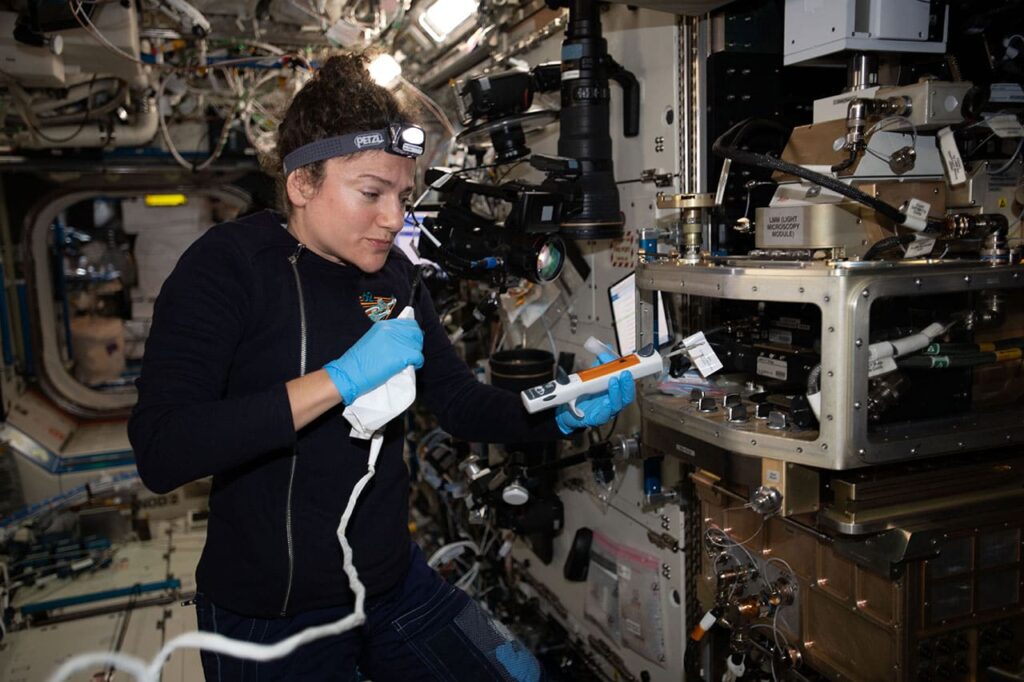Advanced Colloids Experiments
Short Name:The short name or acronym of the facility. ACE

Facility Description
The Advanced Colloids Experiments (ACE) hardware is retired and unavailable. Please see the additional information section below for currently available ISSInternational Space Station hardware and facilities that can support similar investigations.
The ACE series of experiments included ACE-H (Heated), ACE-M (Microscopy), ACE-T (Temperature controlled), and ACE-E (Electric field). Samples were mounted inside the Light Micorscopy Module (LMM) microscope onboard the ISS for analysis. The persistent microgravityThe condition of perceived weightlessness created when an object is in free fall, for example when an object is in orbital motion. Microgravity alters many observable phenomena within the physical and life sciences, allowing scientists to study things in ways not possible on Earth. The International Space Station provides access to a persistent microgravity environment. environment of the ISS enabled the removal of gravitational jamming and sedimentation, allowing researchers to study how order arises from disorder in colloidal suspensions subject to various applied conditions and to learn to control the process.
Availability:The general availability status of the facility. Not available. Please contact the facility manager with any questions.
ISS Environment:The facility location (internal or external to the ISS.) Internal
Owner:The entity that owns the facility. NASA
Operator/Implementation Partner:The entity or ISS National Lab Implementation Partner that operates the facility.
NASA
Developer(s):The entity, or entities, that developed the facility.
ZIN Technologies
Facility Manager:The name of the facility manager and their organization.
John McQuillen,
NASA Glenn Research Center
Manager Email:The facility manager's email address.
john.b.mcquillen@nasa.gov
Parent Facility:Any facility that is necessary to operate the facility described on this webpage. i.e., a parent facility is one level higher in the operational hierarachy. LMM
Child Facility:Facilities that can be operated within the facility described on this webpage.
Sponsoring Space Agency:The government space agency that sponsors investigations that use the facility. NASA
Equipment Category:"The facility's ISS National Lab equipment designation type. Designations include:
1. ISS National Lab Commercial Service Provider (CSP) Facility
2. Support Hardware
3. Capability Capability
Additional Information:Additional resources to learn more about the facility.
Below are three recent ISS investigations involving the dynamics of colloidal suspensions.
Bimodal Colloid – using the KERMIT microscope
Active Colloids in Microgravity – using TangoLab
MaRVIn-TABOOS – using MaRVIn
Past ACE investigations on NASA’s SSRE
ACE-H-1
ACE-H-2
ACE-M-1
ACE-M-2
ACE-M-3
ACE-T-1
ACE-T-2
ACE-T-4
ACE-T-5
ACE-T-6
ACE-T-7
ACE-T-9
ACE-T-10
ACE-T-11
ACE-T-12
ACE-T-Ellipsoids
More information from NASA’s Glenn Research Center
ACE
iss062e014349 (Feb. 16, 2020) --- A view of NASA astronaut Jessica Meir configuring the Light Microscopy Module (LMM) for the Advanced Colloids Experiment-Temperature-4 (ACE-T-4) science in the Destiny module aboard the International Space Station (ISS). Introducing disorder to a crystalline system in a controlled way can form glass. Advanced Colloids Experiment-Temperature-4 (ACE-T-4) examines the transition of an ordered crystal to a disordered glass to determine how increasing disorder affects structural and dynamic properties.
